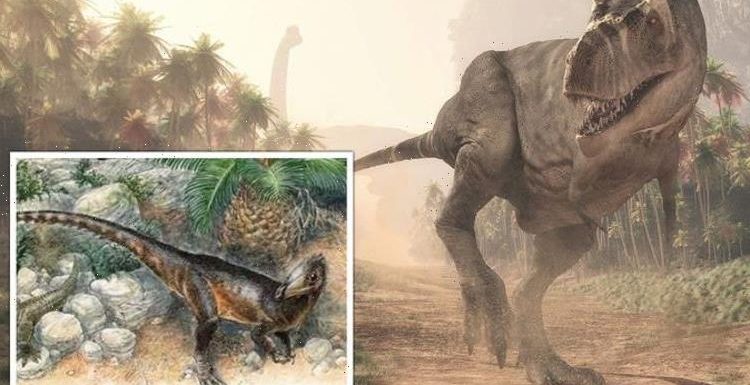
Tyrannosaurus rex: Expert examines brain of dinosaur
We use your sign-up to provide content in ways you’ve consented to and to improve our understanding of you. This may include adverts from us and 3rd parties based on our understanding. You can unsubscribe at any time. More info
The chicken-sized dinosaur was discovered in a quarry in southern Wales where its fossilised remains were hidden for more than 200 million years. Researchers at the Natural History Museum (NHM) and the University of Birmingham have now identified the dino as the UK’s oldest theropod – a family of dinos from which modern-day birds descend – and only the third dino species discovered in Wales. The new species was named Pendraig milnerae after the Welsh word for “chief dragon” and in honour of Dr Angela Milner, who served as Deputy Keeper of Palaeontology at the NHM for more than 30 years.
The Pendraig would have been no bigger than a chicken and measured about 3.2ft (one metre) from snout to tail.
But despite its diminutive stature, the dino would have been an apex predator during the Late Triassic.
Scientists estimate the Pendraig lived between 200 and 215 million years ago
Dr Stephan Spiekman, a Research Fellow at the NHM, said: “Pendraig milnerae lived near the beginning of the evolution of the meat-eating dinosaurs.
“It’s clear from the bones we have that it was a meat-eater, but early in the evolution of this group these animals were quite small, in contrast to the very famous meat-eating dinosaurs like T-Rex which evolved much later.”


The theropods were the most diverse group of dinosaurs, typically characterised by their two-legged, upright stature and taste for meat.
Modern-day birds evolved from the smallest members of the theropod family, with the oldest bird fossils dating to about 150 million years ago.
Although their teeth once contained rows of sharp teeth, they eventually gave way to beaks.
The Pendraig’s namesake, Dr Milner, died in August this year and played a critical role in the Pendraig’s re-discovery.
The dino’s fossil fragments were originally found in the 1950s in Pant-y-ffynnon but were stashed away in a cupboard in the NHM’s collection alongside crocodile samples.
Dinosaurs: Fossil shows 'different appearance' says expert
Dr Susannah Maidment, a Senior Researcher in paleobiology at the NHM, said: “I told Angela that I couldn’t find the specimen, and so she went away and about three hours later she had.
“Angela was really important in the Museum for many years, she was not only the premier dinosaur researcher but also in a senior administrative position as Deputy Keeper of Palaeontology when women didn’t generally occupy such roles in the Museum, so for me as a student it was really important.
“She really inspired me and was incredibly helpful when I joined the Museum.
“She went out of her way to show me the ropes, and that goes for me and so many others, including three of the authors of this paper.”
According to Dr Spiekman, the area where the Pendraig was discovered would have most likely been an island during the Late Triassic.


This could explain the dinosaur’s tiny stature as island-dwelling species tend to show signs of so-called island dwarfism.
The expert explained: “Because the fossil reptiles from this area, including Pendraig, are all quite small-sized, we used statistical analyses to investigate whether Pendraig might have been an insular dwarf.
“The results indicate that Pendraig is indeed small, even for a theropod of that time period, but not uniquely so.
“Furthermore, based on several characters on the bones, we were able to determine that, although the specimens of Pendraig were not very young, they were also likely not fully grown.
“So Pendraig might have gotten somewhat bigger than the specimens we have so far, which limits our ability to perform reliable body size analyses.”
If proven, it would mark the earliest known case of the evolutionary phenomenon.
The dinosaur’s discovery was presented on Wednesday in the journal Royal Society of Open Science.
Richard Butler, study co-author and Professor of Palaeobiology at the University of Birmingham, said: “Dinosaur discoveries are really rare in Wales, and this is only the third dinosaur species known from the country.
“It’s very exciting to learn more about the dinosaurs that lived here in the UK during the Triassic, right at the dawn of dinosaur evolution.”
Source: Read Full Article